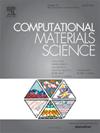Investigation on the aggregation behavior and mechanical properties of silica-filled natural rubber composites: A coarse-grained molecular dynamics study
IF 3.1
3区 材料科学
Q2 MATERIALS SCIENCE, MULTIDISCIPLINARY
引用次数: 0
Abstract
Understanding the particle aggregation behavior in filled rubber is crucial for developing high-performance composite materials. Herein, the effect of the spatial distribution of silica nanoparticles, the length of matrix molecular chains, and the crosslinking of the matrix on the mechanical properties of natural rubber (NR) composites were systematically investigated using coarse-grained molecular dynamics (CGMD) simulations. The results show that with the increase in the degree of silica nanoparticle aggregation, the stress level of the filled rubber in the small deformation stage is significantly increased, but in the large deformation stage, it is significantly reduced. The former can be attributed to the supporting effect of the high strength and rigidity of the particle network in the small deformation stage, while the latter can be attributed to the gradual failure of the particle network in the large deformation stage and the weakening of the adsorption of the particles on the rubber molecular chain. Moreover, it was found that longer molecular chains reduced particle aggregation by enhancing particle encapsulation and interface interactions, while crosslinked networks promoted aggregation behavior by restricting particle mobility through a cage structure. To explain in depth the inherent enhancement mechanism of nanoparticle-filled rubber, microstructure property analysis, such as mean square displacement, interaction energy, and bond orientation, has been implemented and discussed.

求助全文
约1分钟内获得全文
求助全文
来源期刊

Computational Materials Science
工程技术-材料科学:综合
CiteScore
6.50
自引率
6.10%
发文量
665
审稿时长
26 days
期刊介绍:
The goal of Computational Materials Science is to report on results that provide new or unique insights into, or significantly expand our understanding of, the properties of materials or phenomena associated with their design, synthesis, processing, characterization, and utilization. To be relevant to the journal, the results should be applied or applicable to specific material systems that are discussed within the submission.
 求助内容:
求助内容: 应助结果提醒方式:
应助结果提醒方式:


